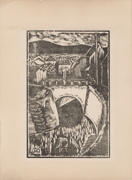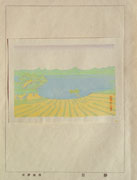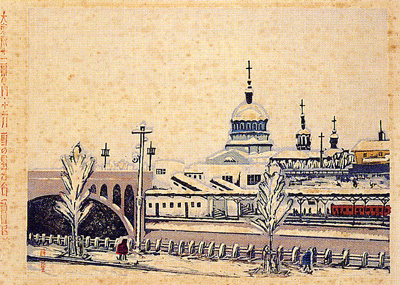Prints in Collection
Iizuka Fūkei
(Landscape of Iizuka), 1928
IHL Cat. #1350
Quiet Day, 1932
IHL Cat. #196
February calendar page from the 1941 Japan Print Association Calendar, 1941
IHL Cat. #2019
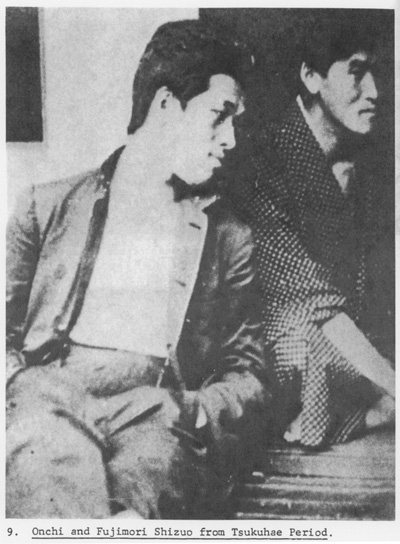 Garland Publishing, Inc. 1986 | ProfileFujimori Shizuo 藤森静雄 (1891-1943) Sources: The Hotei Encyclopedia of Japanese Woodblock Prints, Amy Reigle Newland, Hotei Publishing Company, 2005, p. 432; Guide to Modern Japanese Woodblock Prints: 1900 – 1975, Helen Merritt and Nanako Yamada, University of Hawaii Press, 1992Fujimori Shizuo was born in Kurume, (Fukuoka Prefecture). In1911 he entered the Western Painting Section of the Tokyo School of Fine Arts, from which he graduated in 1916. While at the school he met Onchi Kōshirō (1891-1955) and worked with him on the print and poetry magazine Tsukuhae (Moonglow) to which he contributed 37 prints, several of which are shown below. In 1919 he took part in the first Japan Creative Print Association (Nihon Sōsaku-Hanga Kyōkai) exhibition. Fujimori was a prolific full-time artist, a founding member of the Nihon Hanga Kyōkai in 1931, the principal editor of Shi to hanga, and a contributor to numerous Hanga magazines. He was also one of the contributors of the important series One Hundred Views of New Tokyo (Shin Tokyo hyakkei), along with Maekawa Senpan (1888-1960), Onchi Kōshirō, Takashi Henmi, Hiratsuka Un'ichi (1895-1997), Kawakami Sumio (1895-1972), Sakuichi Fukazawa and Kanenori Suwa between 1929-1932. Fujimori's landscape and figurative styles were heavily influenced by Expressionism. |
Biography
Sources: The British Museum websitehttp://www.britishmuseum.org/research/search_the_collection_database/term_details.aspx?bioId=148537; Images of a Changing World: Japanese Prints of the Twentieth Century, Donald Jenkins, Portland Art Museum, 1983, p. 83; Guide to Modern Japanese Woodblock Prints: 1900-1975, Helen Merritt, University of Hawaii Press, 1992, p. 18-19
Fujimori was born in Kurume (Fukuoka Prefecture) in 1891. He lost his right thumb in an accident as a child, to which his simple carving style is sometimes attributed. In 1910 he attended the Hakuba-kai (Western Painting Institute) where he got to know the woodblock artist Tanaka Kyokichi (1892-1915). In 1911 he began attending the Western Painting Section of Tokyo School of Fine Arts, graduating in 1916. He studied with Kuroda Seiki and Fujishima Takeji and was inspired by Aoki Shigeru, a native of Kurume and nine years his senior. In 1913 he began to make prints under the influence of Tanaka and Onchi Kōshirō (1891-1955) and he co-founded the art and poetry magazine Tsukuhae (Moonglow) with them. He contributed a total of 37 prints to Tsukuhae. Tanaka's terminal tuberculosis in 1915 seems to have injected an element of melancholy in Fujimori's developing expressionistic style. He helped organize the memorial exhibition to Tanaka in 1915.
After his graduation hetaught at middle schools in Taiwan and his native Fukuoka. In Taiwan he met Yamaguchi Gen (1896-1976) and gave him lessons in woodblock carving. After returning to Tokyo he worked as a painter, printmaker and illustrator. He helped found the Creative Print Association in 1918, as he did its successor, the Nihon Hanga Kyōkai, in 1931. He exhibited in the first Japan Creative Print Association (Nihon Sōsaku-hanga Kyōkai) show in 1919 and he contributed to many coterie (dojin zasshi) print magazines. He remained close to Onchi (though working in a much different, more conservative style) and participated with him in the Shin Tokyo Hyakkei (One Hundred Views of Great Tokyo) series (1929-1932), to which he contributed thirteen prints. His work is distinguished by an Expressionistic style increasingly softened by a gentle Romanticism. In 1931, he created his own series Dai Tokyo Junikei (Twelve Views of Great Tokyo), of which two prints are pictured below. From 1936 he began to produce woodblock illustrations for serials in the Fukuoka Asahi Shinbun newspaper. He exhibited with Shun'yokai annually from 1926-1937. In 1938 he edited the first nine prints in the series Shin Nihon hyakkei (One Hundred Views of New Japan.) In 1939 he returned to live in Iizuka, dying in 1943, the year after the sudden death of his eldest son.
Sometimes used the signature SIZ on early prints.  Nature and Life Nature and Lifefrom TSUKUHAE I (1914) "This print, which appeared in Tsukuhae, is characterized by a dynamic composition and suggestive use of color. The night train about to enter a tunnel which seems to represent the severities of life and nature might possibly be a representation of the artist himself at age 23."1 | 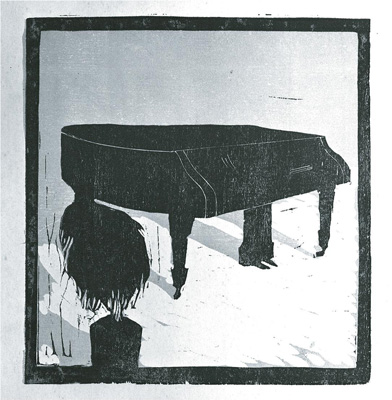 from TSUKUHAE II (1914) 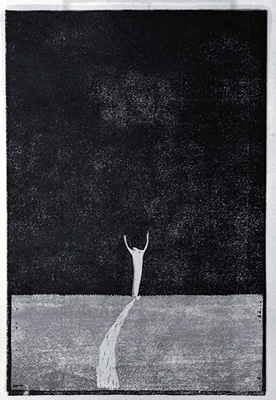 Alienated Person from TSUKUHAE IV (1915) |
1 Fukuoka Art Museum website http://www.fukuoka-art-museum.jp/english/ec/html/ec02/02/fujimori.htm
